Ėį▒Š╩ėŲĄ celebrated the sciences this weekend with two major events: the dedication of the new Robert H.N. Ho Science Center and the launch of the Harvey Picker Institute for Interdisciplinary Studies in the Sciences and Mathematics.
| Guests visit the visualization lab at the Ho Science Center. (Photo by Ian Domes) |
Alumni, guests, and friends of the university were on hand for a range of activities that showcased Ėį▒Š╩ėŲĄŌĆÖs tradition of excellence in the sciences and its vision for exploring the new frontiers of knowledge in the 21st century.
Stories:
- Science building, institute spur new methods of exploration
- Utica Observer-Dispatch story
- News 10 Now story
Photos:
Video:
- Take a look inside building
- Robert H.N. HoŌĆÖs remarks
- Adam Burnett talks about GIS labs, weather station
- Architect Kevin Triplett discusses building
- David Baird details technology in center
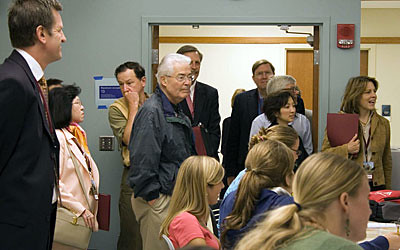 |
| Robert H.N. Ho ŌĆÖ56 (center) watches Ėį▒Š╩ėŲĄ students work Saturday in the new interdisciplinary science center that bears his name. (Photo by Ian Domes) |
Science building, institute spur new methods of exploration
ŌĆ£A glorious day for Ėį▒Š╩ėŲĄ.ŌĆØ
That is how President Rebecca Chopp on Saturday described the dedication of the Robert H.N. Ho Science Center and the formal launch of the Harvey Picker Institute for Interdisciplinary Studies in the Sciences and Mathematics.
|
Video |
In front of dozens of Ėį▒Š╩ėŲĄ alumni, professors, students, and friends gathered in the gleaming second floor of the science center, Chopp spoke of the unprecedented opportunities and access that will push the university into the forefront of interdisciplinary scientific research in the 21st century.
Chopp spoke movingly of the contributions of Robert H.N. Ho ŌĆÖ56, whose $27 million confirmed commitment to the science center project turned a long-held dream into a stunning 121,000-square-foot reality.
The president cited the significant contributions Ho had made to Ėį▒Š╩ėŲĄ in past years, and how their shared vision for the universityŌĆÖs future developed into a genuine friendship that she cherishes.
She also thanked the many alumni, faculty and staff members, and workers from around Central New York who played key roles in ŌĆ£this magnificent building.ŌĆØ
Provost and dean of the faculty Lyle Roelofs and trustee Denis F. Cronin ŌĆÖ69 both mentioned how the vision and contributions of Charles McClennen, the longtime geology professor who died in January, were crucial to the project, which was first discussed some 10 years ago.
ŌĆ£The building is CharlieŌĆÖs last gift to us,ŌĆØ said Roelofs, whose remarks, along with the other speakersŌĆÖ, are to be placed in a time capsule at the center that will be opened in 2057..
Roelofs took Ho and his guests, some of whom traveled from Hong Kong and Canada, on a tour of the building earlier in the day.
Ho said the high-tech classrooms and labs, including the 3D visualization lab, will be the envy of other liberal arts institutions everywhere.
While acknowledging how proud and happy he is to contribute to the center, Ho said: ŌĆ£Although I have delivered the bricks and mortar to Ėį▒Š╩ėŲĄ, I believe the real gift, the most enduring gift, is the use to which the faculty and students of colgate will put this new building.ŌĆØ
Members of the audience stood and applauded as Ho, citing a Chinese proverb, concluded his remarks by saying ŌĆö ŌĆ£I drank water, and I remembered its source.ŌĆØ
ŌĆö Tim OŌĆÖKeeffe, Office of Public Relations and Communications
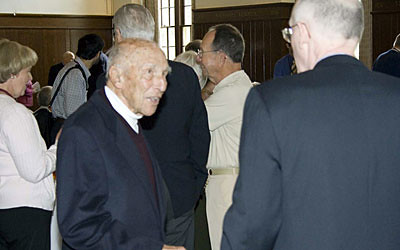 |
| Harvey Picker ŌĆÖ36 talks with guests at the luncheon held in his honor at the Hall of Presidents on Saturday. (Photo by Ian Domes) |
Institute will foster creation of knowledge through collaboration
Harvey Picker ŌĆÖ36, a trustee emeritus whose family has supported Ėį▒Š╩ėŲĄ for more than 70 years, distilled the theme of Ėį▒Š╩ėŲĄŌĆÖs Celebrating the Sciences weekend into one simple yet powerful statement: ŌĆ£No one science will get you where you need to go in the outside world.ŌĆØ
|
Video
|
With his most recent gift to Ėį▒Š╩ėŲĄ, Picker endowed the Harvey Picker Institute for Interdisciplinary Studies in the Sciences and Mathematics, whose inaugural director is Bruce Selleck ŌĆÖ71, Harold Orville Whitnall Professor of geology.
The instituteŌĆÖs mission ŌĆö to foster the creation of new knowledge that is obtainable only through collaboration among faculty and students from disparate disciplines ŌĆö will be realized in the Robert H.N. Ho Science Center, whose revolutionary design has intermingled offices, study lounges, classroom spaces, and laboratories for research in biology, geography, geology, environmental studies, and physics and astronomy.
Gerald D. Fischbach, MD ŌĆÖ60, PŌĆÖ87, HŌĆÖ03, a trustee emeritus and one of Ėį▒Š╩ėŲĄŌĆÖs leading alumni in the sciences, gave the keynote address at SaturdayŌĆÖs luncheon honoring Picker.
Fischbach said that in todayŌĆÖs tumultuous times, Ėį▒Š╩ėŲĄ, with its new Ho Science Center, is perfectly poised ŌĆö because of its size, its superb faculty, its values, and its beauty ŌĆö to help reinvigorate the sciences in America.
ŌĆ£Universities and colleges will be judged by what they have contributed to our understanding of the brain in its broadest sense,ŌĆØ said Fischbach, who studies ParkinsonŌĆÖs disease and autism.
ŌĆ£Brain research is fundamentally interdisciplinary,ŌĆØ he said, in that it requires understanding of physics, chemistry, neuroscience, medicine, and even philosophy. ŌĆ£There are huge ethical issues of what is really informed consent? What kinds of risks are allowable? A liberal education can help us understand not what can we do, but what should we do.ŌĆØ
ŌĆö Barbara Brooks, Office of Public Relations and Communications
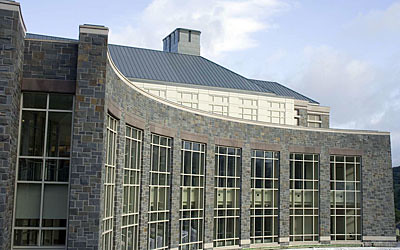 |
| The Robert H.N. Ho Science Center is 121,000 square feet and has more than 50 laboratories. (Photo by Ian Domes) |
Building offers setting to better educate 21st century researchers
Modern scientists must be creative communicators who know how to do research, find new problems, and navigate the intersections between the sciences and the humanities.
This was the assessment of nine panelists, representing colleges and universities, research institutes, and private industry, who gathered in the Meyerhoff Auditorium at the Robert H.N. Ho Science Center on Saturday morning to discuss ŌĆ£Emerging Issues in Science Careers.ŌĆØ
Their conversation quickly turned to the question of how AmericaŌĆÖs academic community can nurture these imaginative investigators when trends indicate a looming shortage of candidates for PhD-level programs.
The answer starts as early as kindergarten. ThatŌĆÖs when students should be introduced to the idea of scientific exploration as a creative activity.
ŌĆ£Science needs to be cool,ŌĆØ said panelist Linda Jones, professor of engineering at Smith College.
Jones also noted that, ŌĆ£as a nation, we have not afforded all students the opportunity to experience science at a young age.ŌĆØ
If AmericaŌĆÖs PhD population is to grow, the sciences must become an intellectual destination for individuals of all races, ethnicities, and genders.
Ėį▒Š╩ėŲĄ administrators say the Ho Science Center is an example of the steps the university is taking to address AmericaŌĆÖs need for a diverse population of researchers grounded in the liberal arts. Its laboratories, which promote faculty-student research projects and interdisciplinary cooperation, go hand-in-hand with a curriculum that encourages wide-ranging scholarship before and after the declaration of a major.
ŌĆ£This building stands as an important message about our commitment to the sciences,ŌĆØ said dean of the college Charlotte Johnson.
ŌĆö Mark Walden, Office of Public Relations and Communications
 |
| Students work Friday in one of the new research laboratories in the Ho Science Center. (Photo by Timothy D. Sofranko) |
Aveni welcomes ŌĆśnew lightŌĆÖ of Ho Science Center
ŌĆ£Think unorthodox curricular thoughts and talk to someone in another discipline,ŌĆØ advised Tony Aveni, professor of astronomy and anthropology and Native American studies, adding ŌĆ£I think Ho Science Center certainly facilitates that.ŌĆØ
Aveni was the guest speaker at FridayŌĆÖs Science Colloquium, in which he gave a ŌĆ£true and partly made upŌĆØ history of five decades in the sciences at Ėį▒Š╩ėŲĄ.
Harking back to 1963, when he began teaching at Ėį▒Š╩ėŲĄ and there were only 350 students and 112 faculty members, Aveni discussed the evolution of the sciences on campus over the years.
Specifically crediting the progressive climate of the late ŌĆÖ60s and early ŌĆÖ70s, Aveni said this was when an interdisciplinary focus forged ahead.
ŌĆ£It was all about re-envisioning ways of knowing, and thinking of new ways to study,ŌĆØ he said.
This was also around the time when Aveni and others started an archaeoastronomy program on campus, the idea of which sprouted at, where else, a faculty tunk.
ŌĆ£ThereŌĆÖs plenty of envisioning happening on campus right now, so here we are conducting a ritual predicting of whatŌĆÖs going to happen in this new science building,ŌĆØ he said.
Refusing to peer into the future, Aveni did conclude with his high hopes for the continued development of the sciences on campus and the role the Ho Science Center will play in that.
ŌĆ£Our new and wonderful home is very closely aligned to the winter solstice sunset,ŌĆØ he joked. ŌĆ£I would like to wish us all to welcome the new light into the Ėį▒Š╩ėŲĄ environment.ŌĆØ
ŌĆö Aleta Mayne, Office of Public Relations and Communications
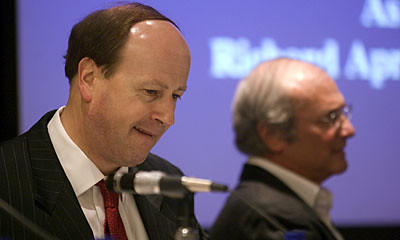 |
| Kevin Triplett (left), senior associate at Shepley Bulfinch Richardson and Abbott, and Rich April, Dunham Beldon Jr. Professor of geology, prepare to discuss the architecture of the Ho Science Center. (Photo by Timothy D. Sofranko) |
Science center has significant architectural impact
ŌĆ£A science building should be as fascinating as science itself,ŌĆØ said Kevin Triplett, senior associate at architecture firm Shepley Bulfinch, describing the philosophy behind the Ho Science CenterŌĆÖs design.
|
Video
|
Triplett was part of a Friday afternoon panel discussion on Ėį▒Š╩ėŲĄŌĆÖs architecture and the campusŌĆÖs newest building.
Triplett outlined the principles and design challenges presented by the projectŌĆÖs weighty parameters ŌĆö a structure two times the size of the next-largest building on campus that needed to fit within the architectural vernacular; a site with a 40-foot change in elevation; and the intention to support new models of collaborative, interdisciplinary learning and research.
Geology professor Richard April began the discussion by outlining how the building came about, from 1997 when the departments housed in Lathrop Hall first identified a need for new space, to the decision to conceptualize a completely new kind of science building, to the approval process that led to its construction.
Geology professor Connie Soja shared the design plans for the Linsley Geology Museum, and biology professor Damhnait McHugh reflected upon the other panelistsŌĆÖ presentations.
ŌĆ£In terms of [the buildingŌĆÖs] contributions to the campus, I remember being on the committee that helped to select the architects, and hearing architects talk about the challenges of this site,ŌĆØ said the panel moderator, art and art history professor Robert McVaugh.
ŌĆ£I want to share my congratulations to Shepley and everyone involved in accomplishing the kind of integration and scale that we have here. It is in architectural terms spectacular ŌĆö and an appropriate solution.ŌĆØ
ŌĆö Rebecca Costello, Office of Public Relations and Communications
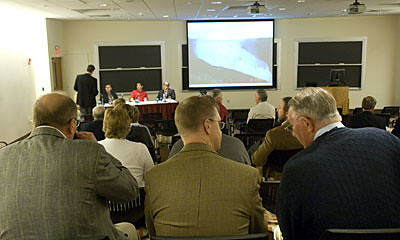 |
| A panel discussion on technology in the sciences kicks off the weekendŌĆÖs events at the Ho Science Center. The session was held in the Meyerhoff Auditorium. (Photo by Timothy D. Sofranko) |
Professors, students to take full advantage of technology
The increasingly busy intersection of technology and scientific research was explored this morning in a panel discussion moderated by Lyle Roelofs, provost and dean of the faculty.
|
Video
GIS labs and weather station |
Geography professor Adam Burnett discussed how his research will be augmented by the new facilities at the Ho Science Center.
A cartographer and climatologist, Burnett said the geographic information system (GIS) lab will be a critical addition.
The lab is the ŌĆ£glueŌĆØ to the kinds of spatial analysis that cut across scientific disciplines, he said, and will allow for a multidisciplinary approach to challenging issues such as climate control.
A weather station is planned for the building and Burnett, whose research on lake-effect snow has been widely publicized, said it will offer real-time data not only for research but for community members who often are forced to rely on unreliable weather reports from outside the Hamilton area.
Brian White ŌĆÖ08, who majors in geology and minors in music, talked about his summer research studying volcanoes in Iceland. He uses an inductively coupled plasma mass spectrometer in his research, and in the new building it will be housed in a ŌĆ£cleanŌĆØ lab.
ŌĆ£ItŌĆÖs an incredible space for us,ŌĆØ he said.
David Baird, director of academic technologies, discussed emerging trends in technology and pointed out the features of the Meyerhoff Auditorium, where the panel discussion was held.
Equipped with the latest wireless and multimedia options, the equipment in the auditorium and in the classrooms are linked to a central server. So if a professor is having trouble with a projector or the document imager, he can call IT members who can access the equipment from their office and quickly correct the problem.
ŌĆö Tim OŌĆÖKeeffe, Office of Public Relations and Communications
Ėį▒Š╩ėŲĄ celebrates sciences with new building, institute
Ėį▒Š╩ėŲĄ is celebrating the sciences this weekend in dramatic fashion with two major events: the dedication of the new Robert H.N. Ho Science Center and the launch of the Harvey Picker Institute for Interdisciplinary Studies in the Sciences and Mathematics.
Alumni, guests, and friends of the university will be on hand for a range of weekend activities.
ŌĆ£This weekend demonstrates the robust nature of our faculty and student initiatives in the sciences and recognizes the generosity of our alumni and friends,ŌĆØ said President Rebecca Chopp.
The $56.3 million science center will house 40 research labs, 45 faculty offices, 13 teaching labs, seven classrooms, a 90-seat lecture hall/auditorium, 60-seat visualization lab, museum, and a teaching/research greenhouse.
It is named in honor of Robert Hung Ngai Ho ŌĆÖ56, who has confirmed a commitment of $27 million to the project.
Faculty members see great opportunities to enhance multidisciplinary study, and the buildingŌĆÖs wealth of shared common spaces, including shared classrooms and configurable laboratories, is intended to enhance collaborative learning.
The interdisciplinary nature of the sciences at Ėį▒Š╩ėŲĄ will be fostered by the new science institute, funded by Harvey Picker ŌĆÖ36.
The institute supports internal and external collaborations among faculty who bring expertise from disparate disciplines to bear on current and emerging scientific problems. It also encourages interdisciplinary approaches to learning through innovative curricular and research opportunities for students.
Here is a schedule (PDF) of this weekendŌĆÖs events.